
|
This article is in four sections. Emission-Absorption-Scattering (EAS) Sub-Quantum Physics EAS Nuclear Glue EAS Neutron Beta Decay EAS Mass Excess
Emission-Absorption-Scattering (EAS)
|

|
|
|
This exposition is about a Newtonian interpretation of electrical attraction and repulsion. It is dedicated to the memory of Glenn Donald Bryant, of Starkville Mississippi, who quested for causality in modern physics. Part 1
|
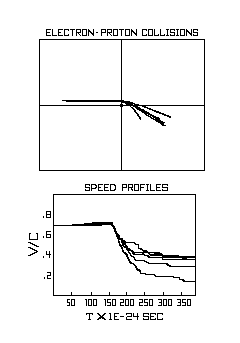
|
Much of the material will deal with things we cannot measure but the concepts can be modeled on a computer and the statistics from the model's history can be compared to experimental observations. For example, shown here are some results of multiple runs of a program called ELECTRON.BAS. This program simulates stochastic electron-proton (e-p) scattering, one electron at a time. Statistics on the changes in momentum and the scattering angles from these runs can be checked against established behavior for actual e-p scattering and the program can be adjusted to more nearly conform to real world averages. It then becomes "predictive" for non-typical events. |
|
I will point out what seems to be a flaw in quantum electrodynamics, (QED)
then outline a model of how electricity may work, and will do so in such a
manner as to fix the flaw. Finally I will show how the model can be used to
explain the braking action of bremsstrahlung.
---------------- In quantum electrodynamics it is customary to describe the electrodynamic interactions of charged particles as being brought about by the emission and absorption of momentum carrying virtual photons. To get an intuitive "feel" for how like charges repel can be fairly straightforward. Let's use a Feymann diagram that shows two electrons interacting to demonstrate this. |
|
The "source" electron (E) emits a virtual photon in the direction of the "absorber" electron (A). In this discussion (maybe not in QED) we can envision a reactive kickback, on the part of the source electron, as the virtual photon is emitted. The virtual photon transits the distance between source and absorber at the speed of light. In the absorption event the virtual photon's momentum is transferred to the absorber which causes it to begin moving away from the source. |
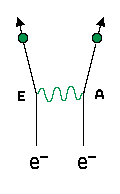
|
| In the case of unlike charges and "attraction" some problems arise. Let's use the same source, as before, and a positron-like absorber. In this simplified approach it would make Paul Dirac unhappy if we used a positron, as shown, without also showing a "liberated" negative energy electron, so we'll pretend that the positive charge is actually a proton with its mass reduced to that of an electron. But let's call it a positron. (This Dirac digression is borrowed from a gentleman at the University of California, Berkeley, who is un-mentioned later.) |
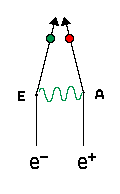
|
|
Again, the source electron emits a virtual photon (which, for our purposes, is indistinguishable from that in the first example). The emitting electron should experience the same recoil as in the first example, i.e., it should be in the opposite direction from that of the virtual photon's path, but it isn't. Conservation of momentum is violated. When the virtual photon's momentum is "delivered" to the positron, it (the positron) responds by moving toward (not away from) the source electron. Again, the process, as depicted, violates conservation of momentum. To me, these violations of conservation of momentum are very problematic. If QED postulates momentum for virtual photons then it should keep its momentum bookkeeping straight. |
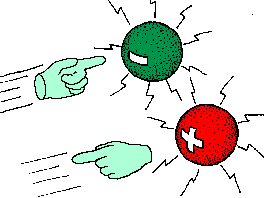
|
Even if I have interpreted this matter improperly, comes the question:
(This question was posed by a gentleman from the then developing Super-Conducting
Super-Collider, on the internet discussion group sci.physics in 1992.)
"How does the virtual photon know, when it arrives at the absorber, whether to push or to pull?" He re-stated the question: "Where, inside the photon, is the information that tells it whether to attract or to repel?" |
|
He was answered by a West Coast physicist: (Both of these gentlemen asked me not
to use their names in connection with this presentation.)
"You ask amiss." He went on to say: "There is no answer. ... We have amplitudes, and we have cross-sections,... but in the final analysis it is the mathematical product of the particles' electric charges that determines attraction or repulsion." (Here, I have paraphrased the respondent's comments somewhat. The earlier matter about Dirac is his also.) I agree with the answer, but I do not like it. QED is primarily mathematically "descriptive" and often does not provide intuitive answers about processes of nature. If we go back to classical electrodynamics, we do not get an answer either. We have a convention: |
Like charges repelandUnlike charges attract.and that is that. |
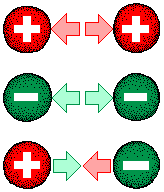
|
|
I will provide one possible way of understanding the "why" of attraction and repulsion, and it will be a Newtonian approach.
|
GRAVITY
|
We don't really know if gravity is a matter of masses pulling on each other or whether they are being pushed towards one another by other, more remote, objects or collections of objects in the universe (via what Hawking calls "their force carrying intermediaries." These intermediaries would be akin to virtual photons. (Dudley's neutrino sea comes to mind.) This is a "push gravity" approach. (Push gravity gets re-invented about every twenty years.) The force carrying intermediaries that get absorbed in the earth should produce a directed shielding effect for other bodies in the vicinity. (This idea lends itself to falsifiable analysis and testing. Perhaps tests can be designed to differentiate between center of mass attraction and solid angle shielding.) |
|
Maybe the problem of attraction and repulsion is not physical but semantic.
The word "attraction" strongly suggests the idea of "pull." If so-called
"attraction" is really a matter of repulsive differentials, we will be hard
pressed while searching for pulling actions.
Newton knew that the hearts of mathematicians were set on the idea of attraction, so he relented and used that word throughout his works. In 1908[1], Swiss physicist Walter Ritz devised a Newtonian theory of retarded elementary interactions. He held that because the Maxwell-Lorentz (solid ether) electromagnetic equations contained solutions in which the future, as well as the past, affect the present, they were, in his words "fundamentally inappropriate for the comprehensive expressions of electrodynamics." (author's translation) His formulae were classical and he dealt solely with retarded potentials which express the idea that time goes from past to future only. This might be expressed clearer by stating that emisson particles coming to us from remote locations in the past can have an effect on a charge in the present, but that future emissions with particles traveling backwards in time to reach our charge have no claim to reality. Ritz's starting idea was borrowed from Newton's emission theory of light. |
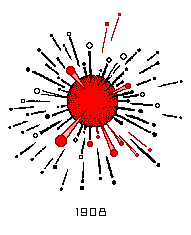
|
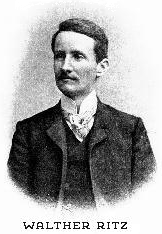
|
|
"Fictitious particles are continuously emitted in all directions by electrical
charges. They keep on moving indefinitely in straight lines with constant speed,
even through material bodies."
Further... 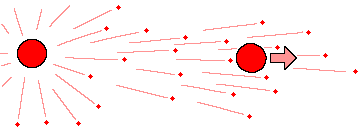
"The action undergone by a charge depends uniquely on the disposition, velocity, etc., of these particles in its immediate surroundings."
In his preliminary work, Ritz dealt with emission particles only. They did not suffer absorptions or deviations in their paths when acting on charged bodies. He knew that his theory was not compatible with Fizeau's experiments on the entrainment of light, but he died before he could finish revising his theory. He died at age 31.
Author's note: Because of absorption and re-emission of electromagnetic
radiation by charges in transparent media [Ewald and Oseen's* extinction theorem(s)].
Ritz's Galilean relativity ideas *Orginally given as "Oseen and Oswald's extinction theorem." These separate studies are related to, but are not directly applicable to Ritz's problem. J.G. Fox[2] used Tolman's more appropriate extinction hypothesis [2a] to ammend Ritz's theory. [R.S.F. 09 Aug 2003.] Ritz's emission particles were so numerous that he could represent them with continuum mathematics. He did not address the mechanics of "how" attraction and repulsion work. He interestingly did say, however, that if charges were allowed to spin he could explain gravity as a side effect of the spins. [3] QED addresses emissions and absorptions, but these are statistical expedients and for simplicity's sake tend to be portrayed as "one-shot" affairs. (That's not exactly the right way to say it, but Feynman diagrams tend to make things seem that way.)

The model I work with is conceptually situated between Ritz's continuum model and QED. You could call it sub-quantum electrodynamics. I opted to add scattering events to the model so as to offer an explanation of attraction and repulsion. Scattering events may not be necessary, but we do have to have a difference in the amount of momentum transferred depending on whether like-charged or unlike-charged emitters and absorbers are involved. I postulate the existence of two types of sub-quantum particles, one type for each kind of charge.
Positive and Negative Chargelets
|
|
If we look at a time average depiction of the emission patterns for a proton
and electron which are in close proximity, we can draw concentric circles
around each charge to represent cross-sections of equipotental surfaces.
These circles represent effects of emission fluxes averaged over a time
period that is much longer than the emission repetition intervals.
The fraction of the proton's positive chargelets that are absorbed by the electron (and don't come out the other side) will produce a "down wind" shadow-zone which will appear as a wedge-like indentation in the two dimensional drawing. In like manner, negative chargelets that are absorbed by the proton produce a shadow-zone behind the proton. |
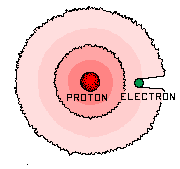
|
|
These shadow-zones produce fractional reductions in repulsion potential of
the charge pair with respect to other charges. (With the charges in a constant
state of motion the reductions get smeared about, but their effects do not go to
zero.) They are contrary to the superposition principle for electric
charges, but the charges in this model are postulated to have finite sized
operational surfaces and can be considered as being "opaque" to the passage
of positive chargelets and negatrinos.
The shadow-zones are postulated to be the electromagnetic cause of gravitation. No gravitons, just positie and negative chargelet flux shadows. (Inertial effects have to be dealt with too.) Even though Ritz did not like the idea of ether, his, and the EAS particles actually constitute a gaseous ether, with electrons and protons as its sources, sinks, and "containment" system. Now, as to why scattering was added to the model. From billiard ball physics we know that for particles having the same mass, elastic collisions deliver twice the momentum transfer (impulsive punch) as do inelastic collisions. When a proton emits a positive chargelet (an inelastic process) or when a negative chargelet is absorbed by a proton (also an inelastic process) the impulse to the emitter or the absorber respectively is one half that of when a positive chargelet elastically scatters with a proton. The same goes for a negative chargelet being emitted by an electron or a positive chargelet being absorbed by an electron as compared to a negative chargelet scattering with an electron. 
Emission recoils are equal and opposite to absorption impulses. Here, I assume that the electrons and protons are moving slowly with respect to the speed of the positive and negative chargelets, which is more or less the speed of light.
|
| In the EAS model, all charges repel, but unlike charges repel each other half as much as like charges. Thus, they tend to get pushed together. This togetherness function is called attraction but really it's the electrodynamic environment impelling unlike charges closer together. |
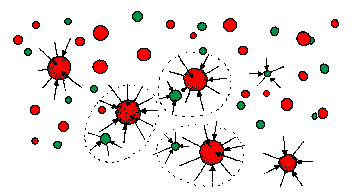
|
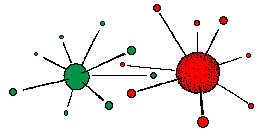
|
If we think of a universe consisting of only one electron and only one proton ... would they move together or move apart? |
|
. . .
I say, they would move away from one another. I said that to say this: We have no isolated charges anywhere in the observable universe. There is a kind of electrodynamic Mach's principle (remote charges set the stage for what happens locally) that enters into every interaction of electrical charges. What is missing from the Feynman diagrams for, so called attraction, is the effect of the external environment on the electron and positron Now, to let the EAS model "explain" the braking action of bremsstrahlung. Suppose, for simplicity, we have a proton whose job it is to slow down rapidly passing electrons. We should keep in the back of our minds that there are all kinds of EAS particles involved but let's concentrate only on the particular set of incoming negative chargelets (those converging on the proton) which hit the electrons and impel them toward the proton. And we will deal with electrons whose approach speed is near the speed of light.
As the electron is inbound, the negative chargelet collisions (by negative chargelets which are converging on the proton) are from the rear. In this model, the impulses they deliver to the electron are proportional to their closure rates relative to the electron. If the negatrinos are going the speed of light, and the electron is going 99.9 percent the speed of light, in the same direction, the "tail-ender" collisions will have a closure rate of .1 percent the speed of light, and their effect will be minimal. The electron cannot acquire very much speed increase. [This is related to Ritz's hypothesis that instead of mass approaching infinity as objects approach the speed of light, electrodynamic accelerating influences/actions approach zero. See Ritz, (1908) page 194.[1]

As the electron passes by the proton, the inbound negative chargelets hit it from the side at full force and can cause its path to change direction, but with little change in speed. Here comes the fun part!As the electron heads outbound it will be running head-on into the inbound negative chargelets. The collisions will have a closure rate of almost two times the speed of light and this will produce a dramatic braking action. This is handwaving but the computer model [4] lends it credence. Since all these collisions are on a so-called chaotic basis, it is conceivable that every now and then an electron could shoot past the proton and suffer very few collisions and hence curve very little and brake very little. If an extra bunch of negative chargelets happen to hit the electron from the side, while it is passing the proton, and relatively few [inbound] negative chargelets hit it while outbound, we could get bending of the path with minimal braking.
This presentation is based on a talk given at the International Conference on Isaac Newton, in St. Petersburg, Russia, hosted by the Russian Academy of Sciences, 22-27 March 1993. A modified version was presented at the Southwest and Rocky Mountain Division of the American Association for the Advancement of Science Annual Meeting at Texas A&M University, May 18-22 1997. Although not mentioned earlier, the EAS model is a Theory Of Everything. The author just doesn't have electrons and protons figured out yet. [Added 28 May 2005.] See The EAS Nuclear Glue , EAS Neutron Beta Decay, and EAS Mass Excess for added discussions based on ideas presented in this article.
Notes on the former use of the words Positrinos and Negatrinos
|